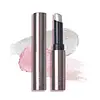What's inside
What's inside
 Key Ingredients
Key Ingredients

 Benefits
Benefits

 Concerns
Concerns

 Ingredients Side-by-side
Ingredients Side-by-side

Water
Skin ConditioningCalcium Aluminum Borosilicate
Propanediol
SolventChondrus Crispus
MaskingSynthetic Fluorphlogopite
Pentylene Glycol
Skin ConditioningSaccharide Isomerate
HumectantTin Oxide
AbrasiveHydroxyacetophenone
AntioxidantSilica
AbrasiveTetrasodium Glutamate Diacetate
Calcium Chloride
AstringentCaprylyl Glycol
Emollient1,2-Hexanediol
Skin ConditioningSodium Citrate
BufferingCitric Acid
BufferingTitanium Dioxide
Cosmetic ColorantIron Oxides
Water, Calcium Aluminum Borosilicate, Propanediol, Chondrus Crispus, Synthetic Fluorphlogopite, Pentylene Glycol, Saccharide Isomerate, Tin Oxide, Hydroxyacetophenone, Silica, Tetrasodium Glutamate Diacetate, Calcium Chloride, Caprylyl Glycol, 1,2-Hexanediol, Sodium Citrate, Citric Acid, Titanium Dioxide, Iron Oxides
Water
Skin ConditioningSynthetic Fluorphlogopite
Glycerin
HumectantPropylene Glycol
HumectantCI 77891
Cosmetic ColorantChondrus Crispus
Masking1,2-Hexanediol
Skin ConditioningMica
Cosmetic ColorantHydroxyacetophenone
AntioxidantCalcium Chloride
AstringentCaprylyl Glycol
EmollientTetrasodium Glutamate Diacetate
Betaine
HumectantPEG-20 Glyceryl Cocoate
Butylene Glycol
HumectantGlucose
HumectantParfum
MaskingTin Oxide
AbrasiveMaltitol
HumectantHippophae Rhamnoides Extract
MaskingHibiscus Mutabilis Flower Extract
Skin ConditioningSodium Hyaluronate
HumectantWater, Synthetic Fluorphlogopite, Glycerin, Propylene Glycol, CI 77891, Chondrus Crispus, 1,2-Hexanediol, Mica, Hydroxyacetophenone, Calcium Chloride, Caprylyl Glycol, Tetrasodium Glutamate Diacetate, Betaine, PEG-20 Glyceryl Cocoate, Butylene Glycol, Glucose, Parfum, Tin Oxide, Maltitol, Hippophae Rhamnoides Extract, Hibiscus Mutabilis Flower Extract, Sodium Hyaluronate
Ingredients Explained
These ingredients are found in both products.
Ingredients higher up in an ingredient list are typically present in a larger amount.
1,2-Hexanediol is a synthetic liquid and another multi-functional powerhouse.
It is a:
- Humectant, drawing moisture into the skin
- Emollient, helping to soften skin
- Solvent, dispersing and stabilizing formulas
- Preservative booster, enhancing the antimicrobial activity of other preservatives
Calcium chloride is a white, odorless, crystalline solid. It is an astringent and can be used to change the viscosity of products.
This ingredient is highly soluble in water, acetic acid, and ethanol.
There are many forms of this ingredient, including monohydrate, dihydrate, tetrahydrate, and hexahydrate.
Learn more about Calcium ChlorideCaprylyl Glycol is a humectant and emollient, meaning it attracts and preserves moisture.
It is a common ingredient in many products, especially those designed to hydrate skin. The primary benefits are retaining moisture, skin softening, and promoting a healthy skin barrier.
Though Caprylyl Glycol is an alcohol derived from fatty acids, it is not the kind that can dry out skin.
This ingredient is also used as a preservative to extend the life of products. It has slight antimicrobial properties.
Learn more about Caprylyl GlycolChondrus Crispus is a red algae native to the northern Atlantic ocean.
It is rich in antioxidants. The polysaccharides, peptides, and amino acid content helps moisturize skin.
Antioxidants present in chondrus crispus include lutein and zeaxanthin. Lutein has the ability to filter blue light from screens.
Learn more about Chondrus CrispusHydroxyacetophenone is antioxidant with skin conditioning and soothing properties. It also boosts the efficiency of preservatives.
This ingredient is not irritating or sensitizing.
Synthetic Fluorphlogopite is the synthethic version of mica. It consists of fluorine, aluminum and silicate.
Synthetic Fluorphlogopite is used to add volume to products.
It is considered non-irritating on the skin.
Learn more about Synthetic FluorphlogopiteTetrasodium Glutamate Diacetate is a chelating agent. Chelating agents help prevent metal ions from binding to other ingredients. This helps prevent unwanted effects and reactions from a product. These metal ions may come from water and are found in miniscule amounts.
Tetrasodium Glutamate Diacetate can also help other preservatives be more effective.
Tin Oxide is an inorganic oxide used to add opacity and volume to a product. In nature, it is already found in mineral form. The main ore of tin is an opaque and shiny mineral called casseterite.
Tin Oxide helps remove translucency in a product, or make it more opaque. Besides adding opacity, tin oxide is used for bulking to add volume.
Water. It's the most common cosmetic ingredient of all. You'll usually see it at the top of ingredient lists, meaning that it makes up the largest part of the product.
So why is it so popular? Water most often acts as a solvent - this means that it helps dissolve other ingredients into the formulation.
You'll also recognize water as that liquid we all need to stay alive. If you see this, drink a glass of water. Stay hydrated!
Learn more about Water